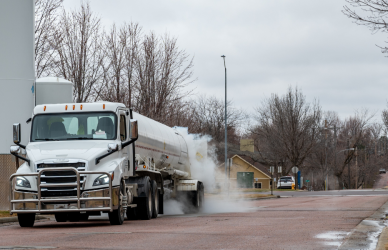Mark your calendars! The Commercial Vehicle Safety Alliance (CVSA) is hosting Brake Safety Week from August 20-26. This week-long event will focus on brake lining and pad violations, with commercial motor vehicle inspectors conducting full vehicle inspections and removing any trucks with brake-related out-of-service violations until they are fixed.
To prepare for Brake Safety Week, fleets and drivers can take action now to ensure their vehicles are in top shape. And during the event, CVSA-certified inspectors will be collecting brake-related inspection and violation data, which will be shared in a press release later this year.
Keep your commercial vehicles safe and compliant by preparing before Brake Safety Week begins.
About the Brake System Inspections
“The focus of this year’s Brake Safety Week is on the condition of the brake lining and pad,” said CVSA President Maj. Chris Nordloh, of the Texas Department of Public Safety. “Brake lining and pad issues may result in vehicle violations and could affect a motor carrier’s safety rating.”
When conducting the brake portion of a Level I or Level V Inspection, inspectors will do the following.
- Check for missing, non-functioning, loose, or cracked parts
- Check for contaminated, worn, cracked, and missing linings or pads
- Check for S-cam flipover
- Listen for audible air leaks around brake components and lines
- Check that slack adjusters are the same length (from center of S-cam to center of clevis pin) and the air chambers on each axle are the same size
- Ensure the brake system maintains air pressure between 90-100 psi (620-690 kPa) and measure pushrod travel
- Inspect for non-manufactured holes (e.g., rust holes, holes created by rubbing or friction, etc.) and broken springs in the spring brake housing section of the parking brake
- Inspect required brake system warning devices, such as anti-lock braking system (ABS) malfunction lamp(s) and low air-pressure warning devices
- Inspect the tractor protection system, including the bleedback system on the trailer
- Ensure the breakaway system is operable on the trailer
Preparing for Brake Safety Week
Brake Safety Week campaign puts a heavy emphasis on spreading awareness, educating, and conducting outreach programs. The Commercial Vehicle Safety Alliance (CVSA) has laid out the brake-system inspection procedure, providing drivers and motor carriers with a clear understanding of what inspectors will be checking during roadside inspections.
The aim of this transparency is to remind everyone to take a proactive approach to keep their commercial motor vehicles safe and compliant with Federal Motor Carrier Safety Regulations. Improperly installed or poorly maintained brake systems can significantly reduce the braking capacity and stopping distance of large vehicles, thereby creating significant safety risks.
Here are a few things you can do now to be ready for successful Brake Week inspections.
- Check CVSA’s vehicle inspection checklist for details on the brake portion of a Level I and Level V Inspection
- Download the 2023 Brake Safety Week flyer for 10 tips on keeping your brake lining/pad healthy
- View the inspection procedures
- View previous brake-safety campaign results
- Check the latest inspection bulletins. Currently, there are eight in the brakes category. Inspection bulletins provide important information to augment the existing inspection program
About Operation Airbrake
Brake Safety Week is a crucial aspect of the CVSA’s Operation Airbrake Program, aimed at curbing highway accidents through proper brake maintenance and operation. This effort involves roadside checks, educating drivers, mechanics, owner-operators, and others on how to keep their commercial motor vehicles safe.
Source: Trucking Info











